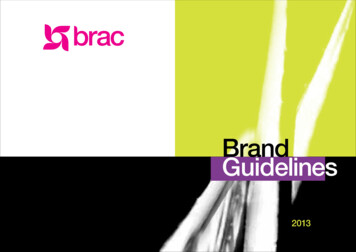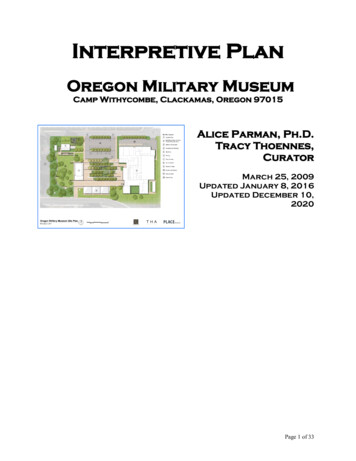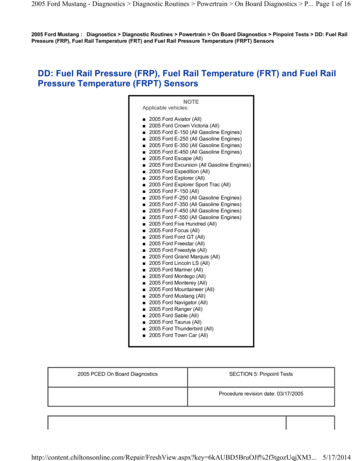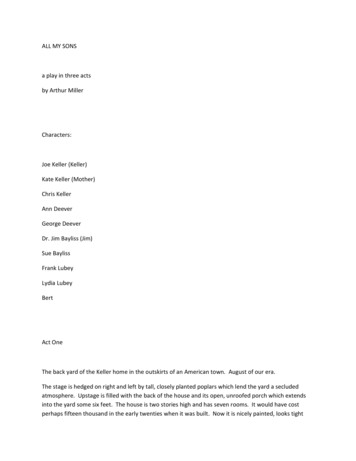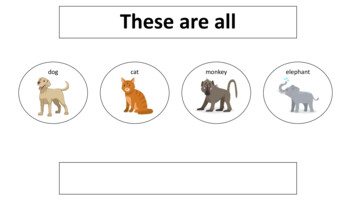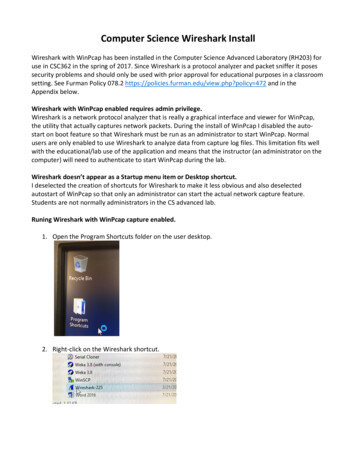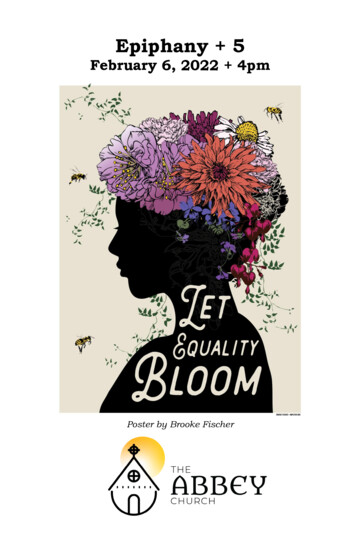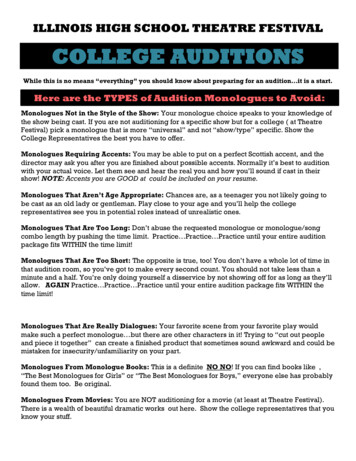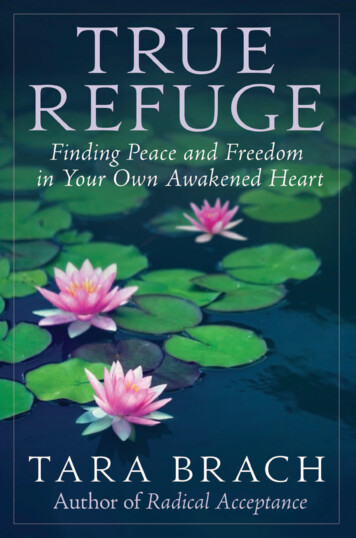
Transcription
To read more of this book, please purchase at http://www.tarabrach.com/products.htmlBrac 9780553807622 4p all r1.indd iv11/1/12 10:57 AM
TRUEREFUGERFinding Peace and Freedomin Your Own Awakened HeartRTara Brach, Ph.D.bantam booksnew yorkBrac 9780553807622 4p all r1.indd v11/1/12 10:57 AM
The names, identifying characteristics, and other details of the clients, students, and othercase studies presented in this book have been changed to protect the privacy and preserve theconfidences of those individuals and their families.Copyright 2012 by Tara BrachAll rights reservedPublished in the United States by Bantam Books, an imprint ofThe Random House Publishing Group, a division of Random House, Inc., New York.Bantam Books and the rooster colophon are registered trademarks of Random House, Inc.Library of Congress Cataloging-in-Publication DataBrach, Tara.True refuge : fi nding peace and freedom in your own awakened heart / Tara Brach.p. cm.ISBN 978-0-553-80762-2eBook ISBN 978-0-345-53862-81. Buddhism—Psychology. 2. Emotions—Religious aspects—Buddhism. I. Title.BQ4570.P76B68 2012294.3'444—dc232012016158Printed in the United States of America on acid-free paperwww.bantamdell.com2 4 6 8 9 7 5 3 1First EditionBook design by Karin BattenBrac 9780553807622 4p all r1.indd vi11/1/12 10:57 AM
contentsRPrologue: Loving Life No Matter WhatxvPart I: Our Search for RefugeoneWinds of HomecomingtwoLeaving Home: The Trance of Small Self516three Meditation: The Path to Presence28Three Gateways to Refuge45fourPart II: The Gateway of TruthfivesixRAIN: Cultivating Mindfulness inDifficult Times61Awakening to the Life of the Body77seven Possessed by the Mind: The Prison ofCompulsive Thinkingeight Investigating Core BeliefsBrac 9780553807622 4p all r1.indd ix9611411/1/12 10:57 AM
ContentsxPart III: The Gateway of LovenineHeart Medicine for Traumatic Fear137tenSelf-Compassion: Releasing the Second Arrow162elevenThe Courage to Forgive181twelveHolding Hands: Living Compassion202thirteen Losing What We Love: The Pain of Separation227Part IV: The Gateway of Awarenessfourteen Refuge in AwarenessfifteenBrac 9780553807622 4p all r1.indd x251A Heart That Is Ready for es291About the Author29311/1/12 10:57 AM
gu i ded r ef lec t ions a n d m edi tat ionsRoneA Pause for Presence15twoLovingkindness: Being Kind to Yourself26threeComing Back41Being Here43fourRemembering the Most Important Thing56fiveBringing RAIN to Difficulty74A Light RAIN: Practicing on the Spot76Bringing RAIN to Pain93The Buddha’s Smile95sixseveneightBrac 9780553807622 4p all r1.indd xiMy Top-Ten Hits110Bringing RAIN to Obsession112Beliefs Inventory13211/1/12 10:57 AM
G uid ed Refl ecti ons and M edi tati o nsxiiCatching Beliefs on the Fly133Lovingkindness: Receiving Love157Tonglen: A Healing Presence with Fear159Self-Forgiveness Scan178Ending the War with Yourself179elevenA Forgiving Heart toward Others200twelveTonglen: Awakening the Heart of Compassion220Lovingkindness: Seeing Past the Mask223Prayer in the Face of Difficulty245ninetenthirteenfourteen Exploring Inner Spacefifteen266Who Am I?267Taking the Backward Step270Prayer of Aspiration282Finding True Refuge283Brac 9780553807622 4p all r1.indd xii11/1/12 10:57 AM
prologu eRLoving LifeNo M at ter WhatMy earliest memories of being happy are of playing in the ocean. Whenour family began going to Cape Cod in the summer, the low pineywoods, high dunes, and wide sweep of white sand felt like a true home.We spent hours at the beach, diving into the waves, bodysurfing, practicing somersaults underwater. Summer after summer, our house filledwith friends and family—and later, with spouses and new children. Itwas a shared heaven. The smell of the air, the open sky, the ever-invitingsea made room for everything in my life—including whatever difficulties I was carrying in my heart.Then came the morning not so long ago when two carloads of friendsand family members took off for the beach without me. From the girlwho had to be pulled from the water at suppertime, I’d become a womanwho was no longer able to walk on sand or swim in the ocean. After twodecades of mysteriously declining health, I’d finally gotten a diagnosis:I had a genetic disease with no cure, and the primary treatment waspainkillers. As I sat on the deck of our summer house and watched thecars pull out of the driveway, I felt ripped apart by grief and loneliness.In the midst of my tears, I was aware of a single longing. “Please, please,may I find a way to peace, may I love life no matter what.”This book came out of my own search for a place of peace, connectedness, and inner freedom, even in the face of life’s greatest challenges. Icall this place “true refuge” because it does not depend on anythingoutside ourselves—a certain situation, a person, a cure, even a particularBrac 9780553807622 4p all r1.indd xv11/1/12 10:57 AM
xvitrue refugemood or emotion. The yearning for such refuge is universal. It is whatlies beneath all our wants and fears. We long to know we can handlewhat’s coming. We want to trust ourselves, to trust this life. We want tolive from the fullness of who we are.My search for refuge led me deeper into the spiritual teachings andBuddhist meditation practices that were so central to my life. I am aclinical psychologist and had been teaching meditation for over thirtyyears. I am also the founder and senior teacher at the Insight MeditationCenter in Washington, D.C. My inner work and work with others gaverise to my first book, Radical Acceptance, and I also started training psychologists and laypeople on how to bring meditation into emotionalhealing. At the time of my diagnosis, as the insecurity of this existenceshook my inner world, the teachings that had always guided me becamemore embodied and alive.In the Buddhist tradition in which I teach, the Pali word “dukkha”is used to describe the emotional pain that runs through our lives. Whileit is often translated as “suffering,” dukkha encompasses all our experiences of stress, dissatisfaction, anxiety, sorrow, frustration, and basic unease in living. The word “dukkha” originally referred to a cart with adamaged wheel. When we are suffering, we are out of balance, joltinguncomfortably along the road of our life. We feel broken or “off,” disconnected from a sense of belonging. Sometimes this shows up as mildrestlessness or discontent; at other times, as the acute pain of grief orgrip of fear. But if we listen deeply, we will detect beneath the surface ofall that troubles us an underlying sense that we are alone and unsafe,that something is wrong with our life.In Radical Acceptance, I wrote about the deep and pervasive suffering ofshame, the pain of believing that “something is wrong with me.” I am nowaddressing dukkha in a broader sense. Since that book was published,I’ve encountered major loss—the death of my father, the physical andmental decline of dear ones, and the challenges of my own chronic illness. Many of my students have also had their lives overturned. Somehave been uprooted from their jobs; they worry about having enough tolive on, and are hungry for meaningful work. Others are estranged fromfamily and friends and long for connection. Many more are grapplingwith aging, sickness, and the inevitability of death. For them, “some-Brac 9780553807622 4p all r1.indd xvi11/1/12 10:57 AM
Lovi ng L i fe No M atter W h atxviithing is wrong with me” has become entangled with the pain of struggling against life itself.The Buddha taught that this experience of insecurity, isolation, andbasic “wrongness” is unavoidable. We humans, he said, are conditionedto feel separate and at odds with our changing and out-of-control life.And from this core feeling unfolds the whole array of our disruptiveemotions—fear, anger, shame, grief, jealousy—all of our limiting stories, and the reactive behaviors that add to our pain.But the Buddha also offered a radical promise, one that Buddhismshares with many wisdom traditions: We can find true refuge withinour own hearts and minds—right here, right now, in the midst of ourmoment-to-moment lives. We find true refuge whenever we recognizethe silent space of awareness behind all our busy doing and striving. Wefind refuge whenever our hearts open with tenderness and love. We findrefuge whenever we connect with the innate clarity and intelligence ofour true nature.In True Refuge, I use the word “presence” to try to capture the immediacy and aliveness of this intrinsic awareness. Presence is hard to describe, because it’s an embodied experience, not a concept. For me, whenI sense the silent, inner wakefulness that is here, I come home to a senseof wholeness. I’m at home in my body and heart, at home in the earthand with all beings. Presence creates a boundless sanctuary where there’sroom for everything in my life— even the illness that keeps me fromsurfing the waves.This book is filled with stories of people discovering presence in themidst of crisis and confusion. It also explores some of the greatest challenges I myself have faced over these past decades. I hope some of thesestories connect to the heart of your own situation. Through them, we’llexplore the forces that draw us away from presence, and why we so oftenpursue false refuges. I also suggest many different practices— some ancient, some new, some specifically supported by modern neuroscience—that have reliably opened me and many others to presence. These includeone of the most practical, in-the-trenches mindfulness meditations I’veworked with in years. Called RAIN (an acronym for the four steps ofthe process), it helps you address many difficult emotions on the spotand can be personalized to almost any situation.Brac 9780553807622 4p all r1.indd xvii11/1/12 10:57 AM
xviiitrue refugeTrue Refuge is organized around three fundamental gateways to refugethat are found in every stream of Buddhism as well as within many othertraditions: truth (of the present moment), love, and awareness. As youwill see, each of these gateways opens us directly to healing and spiritualfreedom. They are the keys to overcoming very common difficultiessuch as obsessive thinking, limiting beliefs, and traumatic fear, and totapping into self-compassion and intimacy in relationships. They arealso the key to finding peace and happiness, to being at home in ourlives.That day on Cape Cod I didn’t know if I could ever be happyliving with a future of pain and physical limitation. While I was crying,Cheylah, one of our standard poodles, sat down beside me and begannudging me with concern. Her presence was comforting; it reconnectedme to the here and now. After I’d stroked her for a while, we got up fora walk. She took the lead as we meandered along an easy path overlooking the bay. In the aftermath of grieving, I was silent and open. My heartheld everything—the soreness of my knees, the expanse of sparklingwater, Cheylah, my unknown future, the sound of gulls. Nothing wasmissing, nothing was wrong. These moments of true refuge foreshadowed one of the great gifts of the Buddhist path—that we can be “happyfor no reason.” We can love life just as it is.If you are drawn to this book, you are already awakening on a pathof true refuge. Perhaps you’ve been at war with yourself and want to bemore kind. You may be struggling with an addiction and long to freeyour life from compulsion and shame. You may be facing loss— of a job,of someone you love, of your health in body and mind—and wonder ifyour heart will ever be whole again. You may be grieving the enormityof suffering in our world and searching for a way to be part of the healing. No matter how challenging the situation, there is always a way to take refuge in ahealing and liberating presence.Writing this book has been a journey of discovery, as I learned everyday from my own experiences and from those around me. My prayer isthat these teachings and practices will offer you company and confidence as we walk the spiritual path together.To read more of this book, please purchase at http://www.tarabrach.com/products.htmlBrac 9780553807622 4p all r1.indd xviii11/1/12 10:57 AM
T ruere f ug eRBrac 9780553807622 4p all r1.indd 111/1/12 10:57 AM
nineRHeart Medicine forTraumatic FearHowDid the roseEver open its heartAnd give to this worldAll itsBeauty?It felt the encouragement of lightAgainst itsBeing.Otherwise,We all remainTooFrightenedhafizWhen Ram Dass suffered a massive cerebral hemorrhage in 1997, hehad more than four decades of spiritual training to help guide him. Oneof the American pioneers in bringing Eastern spirituality to the West,he had explored meditation practices from Hindu, Buddhist, Advaita,and other traditions and introduced several generations to meditationand the path of devoted service. Nonetheless, in the hours after his devastating stroke, he lay on a gurney staring at the pipes on the hospitalceiling, feeling utterly helpless and alone. No uplifting thoughts came torescue him, and he was unable to regard what was happening with mind-Brac 9780553807622 4p all r1.indd 13711/1/12 10:58 AM
138true refugefulness or self-compassion. In that crucial moment, as he put it bluntly,“I flunked the test.”I sometimes tell Ram Dass’s story to students who worry that theytoo have “flunked the test.” They have practiced meeting difficultieswith RAIN, but then they encounter a situation where the fear or distress or pain is so great that they just cannot arouse mindful presence.They are often left with feelings of deep discouragement and self-doubt,as if the door of refuge had been closed to them.I start by trying to help them judge themselves less harshly. Whenwe’re in an emotional or physical crisis, we are often in trance, grippedby fear and confusion. At such times, our first step toward true refuge—often the only one available to us—is to discover some sense of caringconnection with the life around and within us. We need to enter refugethrough the gateway of love.Ram Dass passed through this gateway by calling on Maharajji(Neem Karoli Baba), the Indian guru who had given him his Hinduname, and who had died twenty-four years earlier. In the midst of hisphysical anguish, powerlessness, and despair, Ram Dass began to pray toMaharajji, who to him had always been a pure emanation of love. As helater wrote, “I talked to my guru’s picture and he spoke to me, he was allaround me.” That Maharajji should be immediately “there,” as fullyavailable as ever, was to Ram Dass pure grace. At home again in lovingpresence, he was able to be at peace with the intensity of the moment-tomoment challenge he was facing.The gateway of love is a felt sense of care and relatedness—with aloved one, with the earth, with a spiritual figure, and ultimately, withawareness itself. Just as a rose needs the encouragement of light, we needlove. Otherwise, as poet Hafiz says, “We all remain too frightened.”THE LEGACY OF TRAUMADana had been coming to our weekly meditation group for four monthswhen she approached me one evening after class. She told me that sheneeded more help in dealing with her fear. “Trust doesn’t come easy forme,” she said, “but listening to you calms me down . . . I get the sensethat you’d understand, that I’d feel safe working with you.”Brac 9780553807622 4p all r1.indd 13811/1/12 10:58 AM
T h e Gatew ay o f L ove139Dana did not appear insecure or easily intimidated. A tall, robustAfrican American woman in her late twenties, she had a tough job asa parole officer for a state prison facility. She also had an easy smileand lively eyes, but her words told a different story. “I can be just fine,Tara,” she told me, “and then if I get tripped off . . . I’m a totally dysfunctional person.” Especially when a strong male got angry with her,she said, she’d get “tongue-tied.” “It’s like I’m a scared little girl, a basketcase.”I asked Dana to tell me about some recent times when she’d beentongue-tied with fear. She sat back in her chair, crossed her legs, andbegan nervously tapping the floor with one foot. When she spoke, it wasin a rush of words. “One place it happens is with my boyfriend. Hedrinks—too much—and sometimes he’ll start yelling, accusing me ofthings that aren’t true . . . like that I’m flirting with other men or talkingabout him behind his back.” She stopped for a moment and then continued. “When he gets on my case, you know, threatening me,” she said,“my insides just huddle up into a tight little ball, and it’s like the real medisappears.” At these times she was unable to think or talk. All she wasaware of was the pounding of her heart and a choking feeling in herthroat.Her boyfriend was not the first man to violate her. It soon emergedthat Dana had disappeared into that tight ball over and over again, eversince she was eleven years old and her uncle began to molest her. For fouryears, until he moved out of state, Dana had lived in fear that he woulddrop by when her mother was at work. After each assault, he wouldswear her to secrecy and threaten to punish her if she told. He often accused her of “asking for it”—if she had dressed or acted differently, hesaid, it never would have happened. Even then, a part of her knew thiswasn’t true, but something else in her believed him. “It still does,” shesaid. “It’s like there’s some badness in me that is always waiting to comeout.”Dana was clear about the source of her fears, but that clarity didn’tprotect her from feeling anxious, guilty, and powerless. The next time Isaw her, Dana told me that after our first session, the old terrors of heruncle’s threats had resurfaced. Had she betrayed her boyfriend? Wouldshe be punished for “telling”? Now, just sitting down in my officeplunged her into an old and familiar spiral of fear. She stopped talking,Brac 9780553807622 4p all r1.indd 13911/1/12 10:58 AM
140true refugeher face froze, and her eyes became fixed on the floor. I could see that shewas trembling and her breathing had become shallow. “Are you disappearing inside?” I asked. She nodded without looking up.I was fairly sure that Dana was having a post-traumatic stress reaction. She seemed to have tumbled back into the past, as defenseless andendangered as when her uncle was standing over her. In that moment, Iknew it was unlikely that Dana could access a sense of mindful presence.The fear contraction was too strong.I’ve found that what a person usually needs when fear is intense is to“be accompanied”—an experience of another person’s caring, acceptingpresence. If a child is hurt or frightened, showing that we understandand care about her feelings is more important than looking for a BandAid or explaining why everything will be all right. The core of vulnerability is feeling alone in one’s pain; connection with another personeases fear and increases the sense of safety. However, when a person hasbeen traumatized, it is also important that he or she control the degreeof contact. Otherwise, contact itself could be associated with the traumatizing situation.“Dana,” I said gently, “would you like me to sit next to you?” Shenodded, and patted the cushion right next to her on the couch. When Imoved to her side, I asked her if it was okay for me to sit so close, andshe whispered, “Sure . . . thanks.” I suggested that she make herself ascomfortable as possible. Then she could focus on feeling how her bodywas being supported by the sofa, and how her feet were contacting thefloor. When she nodded again, I encouraged her to notice the felt senseof what it was like for us to be sitting together.Over the next few minutes, I checked in several times, letting herknow I was there with her and asking her if she was okay. She noddedand remained silent, but gradually she stopped trembling and her breathing became deeper and more regular. When I asked again how she wasdoing, she turned her head enough to catch my eye and gave me a smallsmile. “I’m settling down, Tara. It’s better now.” I could tell by the wayshe was engaging—with her eyes and smile—that she no longer felt sotrapped inside her fear.I returned to my chair facing her so we could talk about what hadhappened. “I don’t know what’s wrong with me,” she began. “I should beBrac 9780553807622 4p all r1.indd 14011/1/12 10:58 AM
T h e Gatew ay o f L ove141able to get it together on my own, but when I get stuck like that, it’sembarrassing. I just feel so broken.” Dana realized that she had beentraumatized, and yet she still considered her “episodes,” as she calledthem, to be a sign of weakness and cowardice. Worse, they were evidencethat she was spiritually bereft. As she put it, “I have no spiritual center,it’s just darkness there . . . no soul.”One of the most painful and lasting legacies of trauma is self-blame.Students and clients often tell me that they feel broken, flawed, like“damaged goods.” They may understand the impact of trauma rationally, but they still feel self-revulsion and shame when they feel or actout of control. Their underlying belief seems to be that no matter howawful our experience, we should be able to subdue its terror, quiet ourcatastrophic thinking, and avoid false refuges like addictive behavior orwithdrawing from intimacy. In other words, the self, no matter howdistressed, should always be in control.Inevitably, the small self “flunks the test.” When we’re inside thetrance of a separate, traumatized self, we are trapped in a loop of suffering: Our brains and bodies continuously regenerate the physiology offear, reinforcing our sense of danger and powerlessness. The healing oftrauma, and of the shame that surrounds trauma, requires waking fromthe trance of separation. Dana needed to discover that she could takerefuge in belonging even while the raw feelings of trauma were arising.Our close, personal contact during those disturbing moments in my office was an important first step.UNDERSTANDING TRAUMATrauma is the experience of extreme stress—physical or psychological—that overwhelms our normal capacities to process and cope. When we’rein a traumatized state, we are gripped by primitive survival strategies,and cut off from our own inner wisdom and from the potential resources of the world around us. Our entire reality is confined to theself-sense of being isolated, helpless, and afraid. This profound state ofdisconnection is the core characteristic of trauma, and to some degree,of all difficult emotions.To read more of this book, please purchase at http://www.tarabrach.com/products.htmlBrac 9780553807622 4p all r1.indd 14111/1/12 10:58 AM
We fi nd true refuge whenever we recognize the silent space of awareness behind all our busy doing and striving. We fi nd refuge whenever our hearts open with tenderness and love. We fi nd refuge whenever we connect with the innate clarity and intelligence of our true nature. In True Refuge, I use the word "presence" to try to capture .

